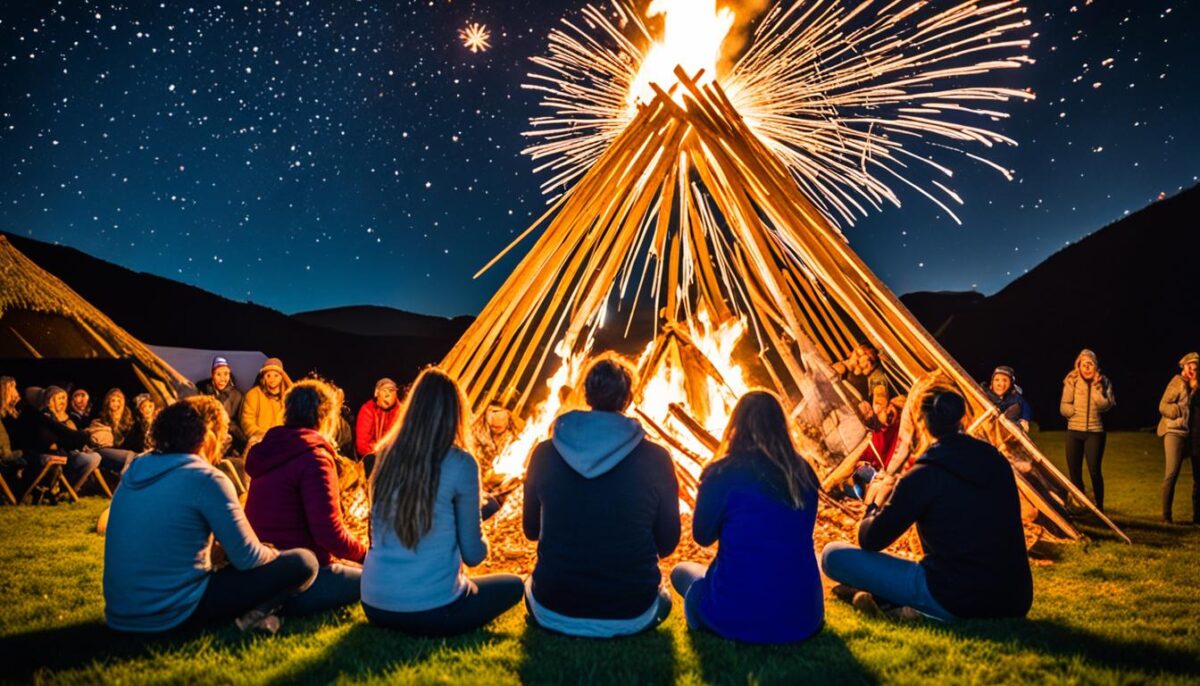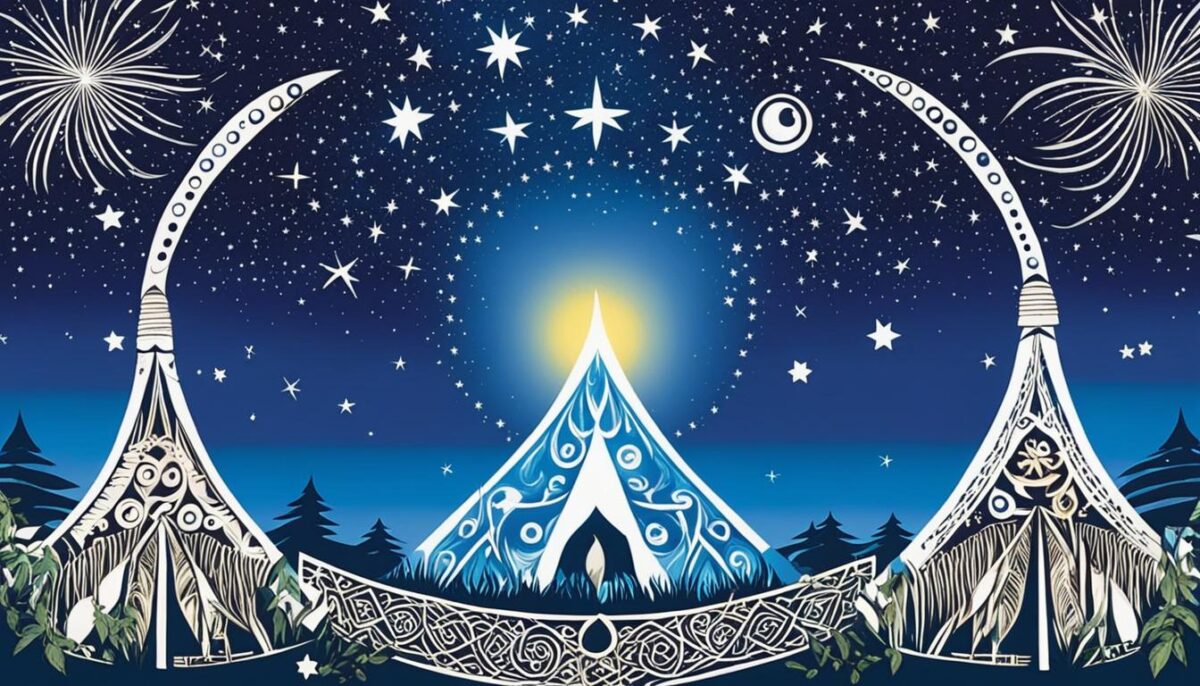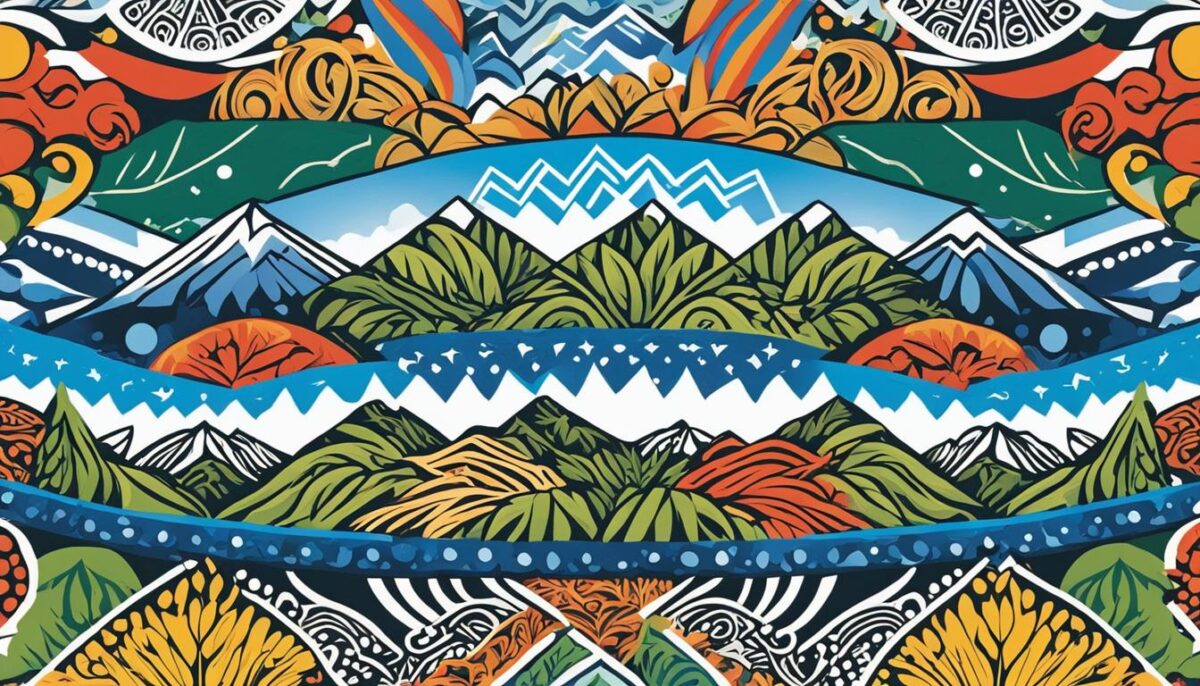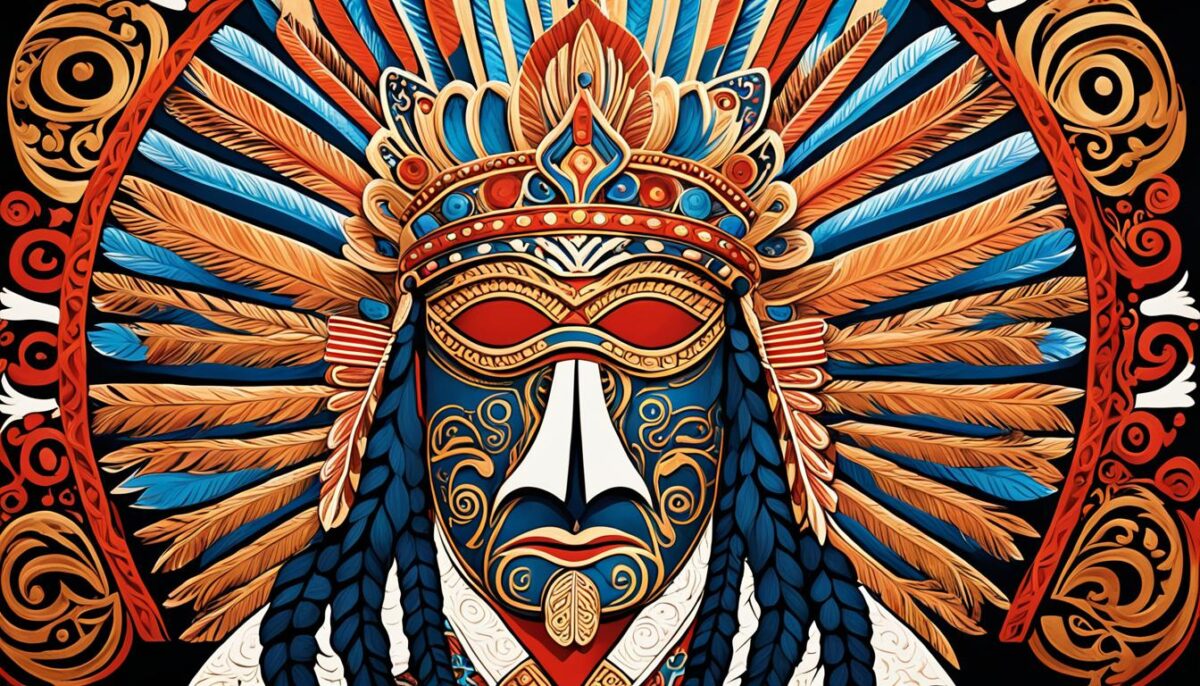In this article, we will delve into the rich traditions of the Māori people of New Zealand and explore how they traditionally celebrated Matariki, a significant celestial event marking the start of the lunar new year. Matariki holds great cultural and spiritual significance for the Māori community, and its celebrations are deeply rooted in their customs and rituals.
Throughout the years, Matariki has been a time of gathering for Māori families and communities, fostering unity and connection. Storytelling plays a vital role in these celebrations, as it allows the passing down of cultural knowledge and ancestral heritage from one generation to another.

Show a group of people gathered around a large bonfire in the middle of a field. They are surrounded by food and musical instruments. In the background, there are several small huts made of straw and wood. Above them, the stars are shining brightly, with Matariki being the brightest of all. One person is holding a large conch shell, blowing it to announce the beginning of the celebration. The others are dancing and singing, their faces lit up with joy and excitement.
During Matariki, the Māori engage in various traditional practices that honor their heritage and celebrate the abundant blessings of the land and the heavens. These practices range from preparing kai, traditional food, to performing waiata, songs, and haka, war dances, rich in cultural symbolism.
Matariki celebrations also carry deep symbolic and spiritual meanings. The seven stars of Matariki hold significance in guiding the Māori agricultural cycles, while also serving as a commemoration of ancestors and a time of reflection on the past.
In recent times, Matariki celebrations have experienced a revival in modern Māori society, with communities actively organizing festivals and engaging the wider public. These events showcase the vibrant cultural expressions of the Māori, from art exhibitions to storytelling sessions, further enriching the appreciation of Māori traditions.
As we delve deeper into the customs, rituals, and significance of Matariki celebrations, we will also explore the future of this important event and its growing recognition as a national celebration in New Zealand. Join us on this journey to discover the beauty and significance of Matariki in the Māori culture.
Māori Matariki Customs and Rituals
When it comes to Matariki celebrations, the Māori people have a rich tapestry of customs and rituals that bring communities together and honor their ancestors. These traditions not only highlight the cultural significance of Matariki but also foster a sense of unity and belonging.
A key aspect of Māori Matariki customs is the gathering of whānau (family) and communities. This time of year serves as an opportunity for loved ones to reunite, share stories, and strengthen bonds. Whānau come together to participate in various activities, such as feasts, dances, and games, creating cherished memories and reinforcing cultural ties.
Storytelling is a paramount practice during Matariki. Through the art of storytelling, the Māori people pass down ancestral knowledge, legends, and wisdom from one generation to the next. This oral tradition ensures the preservation of cultural heritage and promotes a deep understanding of Matariki’s significance.
The Role of Storytelling in Matariki
“As the stars of Matariki light up the night sky, our stories illuminate our cultural identity, connecting us to our ancestors and guiding us towards the future.” – Aroha Williams, Māori storyteller
During Matariki gatherings, elders and skilled storytellers share narratives that encapsulate the history and values of the Māori people. These stories often revolve around the seven Matariki stars and their symbolism, illustrating the interconnectedness between the celestial realm and earthly existence.
Māori Matariki customs also incorporate various rituals that hold deep cultural significance. These rituals may vary across different tribes and regions but often involve expressions of gratitude, remembrance, and spiritual connection.
One common ritual is the lighting of fires or bonfires, representing both the warmth of community and the guiding light of Matariki. The flames dance in harmony with the stars above, symbolizing the eternal connection between humans and the celestial realm.
Another important Matariki ritual is the performance of waiata (songs) and haka (war dances). These artistic expressions serve as a homage to Māori ancestors, reflecting their strength, resilience, and sense of unity. Through waiata and haka, the Māori people honor their heritage and celebrate the spirit of Matariki.
To provide further insight into Māori Matariki customs and rituals, here is a table summarizing some of the key practices:
| Custom or Ritual | Description |
|---|---|
| Gathering of Whānau (Family) and Communities | Bringing loved ones together to foster connections and cultural bonds. |
| Storytelling | Sharing ancestral knowledge, legends, and wisdom through oral traditions. |
| Lighting of Fires | Symbolizing the warmth of community and the guidance of Matariki. |
| Performance of Waiata and Haka | Honoring ancestors through songs and dances that embody Māori spirit. |
These customs and rituals are a testament to the deep connection that the Māori people have with Matariki. Through their observance, the Māori community continues to pass on their traditions, reinforce cultural identity, and celebrate the renewal of life symbolized by this celestial event.
Traditional Māori Practices during Matariki
During the Matariki celebrations, the Māori people observe a range of traditional practices that connect them to their rich cultural heritage and the significance of this celestial event. These practices encompass various activities, each playing a vital role in honoring Māori customs and promoting a sense of community.
Foods that Sustain the Spirit
One of the essential traditional practices during Matariki is kai, the preparation and sharing of food. This is an opportunity for the Māori community to come together and celebrate with a feast. The foods chosen for Matariki often have cultural significance and are prepared using traditional methods. This includes the cooking of hangi, where food is slow-cooked in an earth oven, infusing it with a unique flavor and connecting people to the land.
Cultural Expressions through Song and Dance
Waiata, or songs, and haka, or war dances, hold a significant place in Māori culture. During Matariki, communities gather to perform these traditional forms of expression as a way to connect with their ancestors and celebrate the vibrancy of life. Through waiata and haka, Māori people share stories, celebrate achievements, and honor the spirit of Matariki, fostering a strong sense of identity and unity.
Genealogy and Ancestral Connections
Whakapapa, the practice of reciting genealogy and tracing ancestral connections, is another important tradition during Matariki. It serves as a reminder of the ties that bind Māori communities together, emphasizing the intergenerational connections and the passing down of knowledge and values. Whakapapa fosters a sense of belonging and provides a foundation for understanding one’s place within the larger Māori collective.
These traditional practices during Matariki demonstrate the deep-rooted cultural traditions of the Māori people. Through food, song, dance, and genealogy, they pay homage to their ancestors, strengthen community ties, and celebrate the spiritual and cultural significance of Matariki.
Symbolism and Significance of Matariki Celebrations
Within the Māori culture, Matariki celebrations hold deep symbolism and significance. This annual event revolves around the seven Matariki stars, also known as Pleiades, which rise above the horizon in mid-winter. The appearance of these stars signals the start of the Māori lunar new year, marking a time of reflection, gratitude, and renewal.
One of the key symbols associated with Matariki is the notion of rebirth and new beginnings. Just as the stars emerge from the darkness, Matariki represents a time of transition and the opportunity to leave behind the past and embrace fresh experiences. It serves as a reminder to reflect on personal growth and set intentions for the coming year.
The significance of Matariki extends beyond the celestial realm. It is deeply rooted in the agricultural cycles, as its arrival signifies the beginning of the planting season for crops such as kumara (sweet potato) and other essential food sources for the community. This connection to nature highlights the importance of sustainability, abundance, and the interdependence between humans and the environment.
In the words of Te Awanuiarangi Black, a Māori cultural expert, “Matariki represents unity, the coming together of people, families, and communities to celebrate the bountiful harvest, but also to honor our ancestors and acknowledge the continuity of life.”
Another significant aspect of Matariki celebrations is the remembrance of ancestors. The Māori people pay homage to their forebears during this time, acknowledging the wisdom, knowledge, and guidance they have imparted. It is a time for storytelling, passing down traditions, and connecting with one’s lineage, fostering a sense of identity and cultural pride.
Matariki celebrations are not only about honoring the past but also about fostering community solidarity. Families and communities gather to participate in various festivities, including music, dance, arts, crafts, and feasting. These communal activities strengthen the bonds between individuals and reinforce the importance of collective well-being and support.

Create an image showcasing the traditional Māori celebration of Matariki, with a focus on the symbolism and significance of the festival. Featuring elements of nature, such as the stars and the moon, and traditional Māori cultural elements such as kowhaiwhai patterns and taonga puoro instruments. Show a sense of community and togetherness, with people coming together to celebrate and honor their ancestors and the natural world. Use warm, earthy tones to convey a sense of grounding and connection to the land.
| Symbolism of Matariki Celebrations | Significance of Matariki Celebrations |
|---|---|
| 1. Rebirth and new beginnings | 1. Reflection and personal growth |
| 2. Connection to agricultural cycles | 2. Emphasis on sustainability and abundance |
| 3. Commemoration of ancestors | 3. Preservation and transmission of knowledge |
| 4. Community unity and solidarity | 4. Strengthening communal bonds and support |
Modern Matariki Celebrations and Revival
In this final section, we will explore the modern Matariki celebrations and the revival of this ancient Māori tradition in contemporary society. Over time, Matariki has experienced a renaissance, with Māori communities embracing and revitalizing the customs and rituals associated with this celestial event. Let us delve into the various ways in which Matariki is honored and celebrated in the modern era.
Matariki Public Events
One of the prominent features of modern Matariki celebrations is the organization of public events that bring communities together to commemorate this auspicious occasion. These events often include vibrant cultural performances, live music, traditional arts and crafts exhibitions, and storytelling sessions that showcase the rich tapestry of Māori culture. They serve as platforms for cultural exchange and foster a sense of unity and pride within the Māori community and the wider public.
Educational Initiatives
Recognizing the importance of preserving and passing on the knowledge of Matariki to future generations, educational initiatives play a crucial role in modern celebrations. Schools across New Zealand integrate Matariki into their curriculum, teaching students about its significance, cultural practices, and the astronomical phenomena associated with the event. This educational approach ensures that Matariki remains a living tradition, kept alive through the knowledge and understanding of young learners.
Artistic Expressions
The revival of Matariki celebrations also extends to the realm of art, with contemporary artists using their creative expressions to honor and depict the significance of this celestial event. Paintings, sculptures, and other visual artworks often draw inspiration from the Matariki stars, weaving together traditional and modern motifs to capture the essence and spirit of Matariki. These artistic expressions not only celebrate Māori culture but also contribute to the ongoing revival and preservation of Matariki.
While Matariki celebrations in modern times have evolved and adopted new forms, the revival of this ancient tradition demonstrates the enduring cultural identity and resilience of the Māori people. Through public events, educational initiatives, and artistic expressions, Māori communities continue to honor and celebrate Matariki, ensuring that its significance and rich heritage are cherished for generations to come.
| Modern Matariki Celebrations | Revival Initiatives |
|---|---|
| Public Events | Cultural Performances |
| Educational Initiatives | School Curriculum Integration |
| Artistic Expressions | Visual Artworks |
Matariki Festivals and Community Engagement
Immerse yourself in the vibrant celebration of Matariki by experiencing the diverse Matariki festivals held across New Zealand. These festivals serve as a testament to the strong bond between the Matariki tradition and the local communities. From lively performances to interactive workshops, these events offer a range of activities that foster cultural engagement and appreciation.
During these festivals, communities take an active role in organizing and participating in the festivities, showcasing their artistic talents and sharing their cultural heritage with the wider public. It is a time when people from all walks of life come together to celebrate Matariki, forging connections and strengthening community ties.
Explore the fascinating range of activities and events that engage and captivate festival-goers during the Matariki celebrations. From awe-inspiring exhibitions that showcase Māori art and crafts to immersive storytelling sessions that transport you to a world of ancient legends and traditions, these festivals offer something for everyone.
Engage in workshops and learn traditional crafts and practices passed down through generations. Be enthralled by captivating performances of waiata (songs) and haka (war dances) that encapsulate the essence of Māori culture. Discover the significance of Matariki through enlightening presentations by knowledgeable speakers, and captivate your senses with mouthwatering kai (food) representing the rich culinary heritage of the Māori people.
Below is a selection of some notable Matariki festivals held in different regions of New Zealand:
- Te Matahiapo Matariki Festival: This festival, held in Wellington, showcases a variety of cultural performances, art exhibitions, and traditional workshops. Attendees can immerse themselves in Māori culture while enjoying delicious kai and engaging in interactive experiences that celebrate Matariki.
- Matariki Festival Tāmaki Makaurau: This festival, held in Auckland, is the largest Matariki celebration in New Zealand. It features a diverse range of events, including music concerts, art installations, storytelling sessions, and fireworks displays. Join the community as they unite to honor Matariki and embrace cultural diversity.
- Puaka Matariki Festival: Celebrated in Dunedin, this festival combines both Matariki and Puaka (the Southern Hemisphere equivalent) to honor the rising of the Pleiades and the return of the Southern Cross. Experience the warmth of community spirit through engaging performances, workshops, and stargazing sessions.
These festivals provide a platform for locals and visitors alike to come together, celebrate the Matariki season, and deepen their understanding of Māori traditions and customs. By actively engaging in these festivities, communities contribute to the preservation and revitalization of Māori culture, fostering a sense of unity and cultural appreciation.
Matariki Festivals Across New Zealand
| Festival Name | Location | Date |
|---|---|---|
| Te Matahiapo Matariki Festival | Wellington | June 20 – July 10 |
| Matariki Festival Tāmaki Makaurau | Auckland | June 21 – July 25 |
| Puaka Matariki Festival | Dunedin | June 15 – July 15 |
The Future of Matariki Celebrations
As Matariki, the Māori New Year, continues to gain recognition as a national event in New Zealand, discussions surrounding its future are becoming increasingly significant. Efforts by governmental bodies, educational institutions, and Māori advocacy groups are focused on ensuring the continued observance and promotion of Matariki, preserving its cultural importance for future generations.
Various initiatives have been undertaken to elevate the significance of Matariki within New Zealand’s calendar of celebrations. Governmental support has seen the introduction of public holidays and the inclusion of Matariki in the education curriculum. This recognition of Matariki as a valuable cultural event highlights the commitment to preserving and honoring Māori traditions.
Additionally, educational institutions play a crucial role in promoting Matariki through curriculum integration, cultural events, and community engagement. By embracing Matariki celebrations, schools foster cultural appreciation and understanding among students, ensuring the legacy of Māori culture and traditions continues to flourish.
Māori advocacy groups are also actively involved in championing the future of Matariki celebrations. These groups work tirelessly to organize festivals, exhibitions, and community gatherings that showcase the significance of Matariki. By fostering a sense of pride and connection to Māori heritage, these efforts contribute to the ongoing revitalization of the Matariki traditions.


